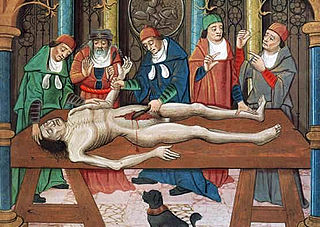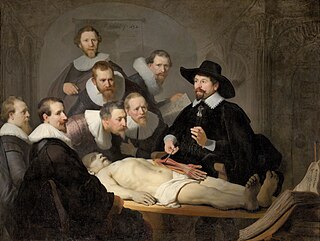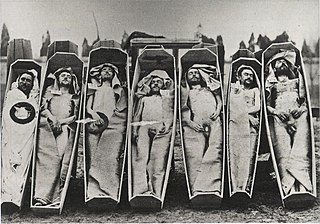
Anatomy is the branch of biology concerned with the study of the structure of organisms and their parts. Anatomy is a branch of natural science] which deals with the structural organization of living things. It is an old science, having its beginnings in prehistoric times. Anatomy is inherently tied to developmental biology, embryology, comparative anatomy, evolutionary biology, and phylogeny, as these are the processes by which anatomy is generated, both over immediate and long-term timescales. Anatomy and physiology, which study the structure and function of organisms and their parts respectively, make a natural pair of related disciplines, and are often studied together. Human anatomy is one of the essential basic sciences that are applied in medicine.

The history of anatomy extends from the earliest examinations of sacrificial victims to the sophisticated analyses of the body performed by modern anatomists and scientists. Written descriptions of human organs and parts can be traced back thousands of years to ancient Egyptian papyri, where attention to the body was necessitated by their highly elaborate burial practices.

The history of anatomy in the 19th century saw anatomists largely finalise and systematise the descriptive human anatomy of the previous century. The discipline also progressed to establish growing sources of knowledge in histology and developmental biology, not only of humans but also of animals.

Mondino de Luzzi, or de Liuzzi or de Lucci,, also known as Mundinus, was an Italian physician, anatomist and professor of surgery, who lived and worked in Bologna. He is often credited as the restorer of anatomy because he made seminal contributions to the field by reintroducing the practice of public dissection of human cadavers and writing the first modern anatomical text.

Dissection is the dismembering of the body of a deceased animal or plant to study its anatomical structure. Autopsy is used in pathology and forensic medicine to determine the cause of death in humans. Less extensive dissection of plants and smaller animals preserved in a formaldehyde solution is typically carried out or demonstrated in biology and natural science classes in middle school and high school, while extensive dissections of cadavers of adults and children, both fresh and preserved are carried out by medical students in medical schools as a part of the teaching in subjects such as anatomy, pathology and forensic medicine. Consequently, dissection is typically conducted in a morgue or in an anatomy lab.

Body snatching is the illicit removal of corpses from graves, morgues, and other burial sites. Body snatching is distinct from the act of Grave robbery as grave robbing does not explicitly involve the removal of the corpse, but rather theft of the burial site itself. The term ‘body snatching’ most commonly refers to the removal and sale of corpses primarily for the purpose of dissection or anatomy lectures in medical schools. The term was coined primarily in regard to cases in the United Kingdom and United States throughout the 17th, 18th, and 19th centuries. However, there have been cases of body snatching ranging across a variety of countries, with the first recorded case dating back to 1319 in Bologna, Italy. Those who practiced the act of body snatching and sale of corpses during this period were commonly referred to as "resurrectionists" "resurrection men". Resurrectionists in the United Kingdom who often worked in teams and who primarily targeted more recently dug graves, would be hired in order to provide medical institutions and practitioners with a supply of fresh cadavers for the purpose of anatomical study. Despite a significant decline in body snatching as a practice, there do exist contemporary instances of body snatching cases occurring around the globe.
The Anatomy Act 1832 is an Act of Parliament of the United Kingdom that gave free licence to doctors, teachers of anatomy and bona fide medical students to dissect donated bodies. It was enacted in response to public revulsion at the illegal trade in corpses.

A prosector is a person with the special task of preparing a dissection for demonstration, usually in medical schools or hospitals. Many important anatomists began their careers as prosectors working for lecturers and demonstrators in anatomy and pathology.

The Anatomy Lesson of Dr. Nicolaes Tulp is a 1632 oil painting on canvas by Rembrandt housed in the Mauritshuis museum in The Hague, the Netherlands. The painting is regarded as one of Rembrandt's early masterpieces.

A cadaver or corpse is a dead human body that is used by medical students, physicians and other scientists to study anatomy, identify disease sites, determine causes of death, and provide tissue to repair a defect in a living human being. Students in medical school study and dissect cadavers as a part of their education. Others who study cadavers include archaeologists and arts students.

The Medical Renaissance, from around 1400 to 1700 CE, was a period of progress in European medical knowledge, with renewed interest in the ideas of the ancient Greek and Roman civilizations along with Arabic-Persian medicine, following the translation into Latin of many works from these societies. Medical discoveries during the Medical Renaissance are credited with paving the way for modern medicine.
A prosection is the dissection of a cadaver or part of a cadaver by an experienced anatomist in order to demonstrate for students anatomic structure. In a dissection, students learn by doing; in a prosection, students learn by either observing a dissection being performed by an experienced anatomist or examining a specimen that has already been dissected by an experienced anatomist

Anna Morandi Manzolini was an internationally known anatomist and anatomical wax modeler, as lecturer of anatomical design at the University of Bologna.
Night Doctors, also known as Night Riders, Night Witches, Ku Klux Doctors, and Student Doctors, are bogeymen of African American folklore with some factual basis. African American folklore told of doctors who would abduct, kill, and dissect, performing a plethora of experiments, referred to as "Night Doctors". Emerging from the realities of grave-robbing, enforced and punitive medical experimentation, the Night Doctors' purpose was to further prevent slaves, freedmen, and black workers from leaving for the Northern United States. The term night doctors is often broadly used, referring to those who steal, buy, or practice on African American corpses to further their medical knowledge. At this time, the cadaver shortage among medical schools in the south led to people digging up their graves in the night to steal bodies, and slave owners selling their deceased to make some extra money. Grave robbing often happened in poor communities where they had no means to have or fund any deterrence of grave robbing or protection of their cemeteries. Night doctors preying on these marginalized communities were often overlooked by wealthier, more powerful people in the communities, and inevitably led to the fleeing of African Americans in the early to mid 20th century, now known as The Great Migration.
An anatomy murder is a murder committed in order to use all or part of the cadaver for medical research or teaching. It is not a medicine murder because the body parts are not believed to have any medicinal use in themselves. The motive for the murder is created by the demand for cadavers for dissection, and the opportunity to learn anatomy and physiology as a result of the dissection. Rumors concerning the prevalence of anatomy murders are associated with the rise in demand for cadavers in research and teaching produced by the Scientific Revolution. During the 19th century, the sensational serial murders associated with Burke and Hare and the London Burkers led to legislation which provided scientists and medical schools with legal ways of obtaining cadavers. Rumors persist that anatomy murders are carried out wherever there is a high demand for cadavers. These rumors, like those concerning organ theft, are hard to substantiate, and may reflect continued, deep-held fears of the use of cadavers as commodities.

Resurrectionists were body snatchers who were commonly employed by anatomists in the United Kingdom during the 18th and 19th centuries to exhume the bodies of the recently dead. Between 1506 and 1752 only a very few cadavers were available each year for anatomical research. The supply was increased when, in an attempt to intensify the deterrent effect of the death penalty, Parliament passed the Murder Act 1752. By allowing judges to substitute the public display of executed criminals with dissection, the new law significantly increased the number of bodies anatomists could legally access. This proved insufficient to meet the needs of the hospitals and teaching centres that opened during the 18th century. Corpses and their component parts became a commodity, but although the practice of disinterment was hated by the general public, bodies were not legally anyone's property. The resurrectionists therefore operated in a legal grey area.

The doctors' riot was an incident that occurred in April 1788 in New York City, where the illegal procurement of corpses from the graves of the recently deceased caused a mass expression of discontent from poorer New Yorkers that was directed primarily at physicians and medical students.

Joseph Nash McDowell (1805-1868) was one of the most influential and respected doctors west of the Mississippi in the 1840s until his death in 1868. He is primarily remembered for his grave-digging practices, where he illegally exhumed corpses in order to study human anatomy. He is also known for his influence on Mark Twain, and was likely the inspiration for Twain's fictional character Dr. Robinson in "The Adventures of Tom Sawyer."
The Pennsylvania Anatomy Act of 1883 is legislation of the State of Pennsylvania to facilitate medical education. This act allowed teachers and students to be able to dissect bodies without have to resort to buying from grave robbers or buying body parts. This act was written to prevent grave robbing, and to even out the availability of corpses.
"An Act to Promote Medical Science and Protect Burial Grounds", informally known as the Bone Bill, was an 1854 bill in New York. Its purpose was to greatly increase the number of cadavers available for legal dissection in medical schools.













